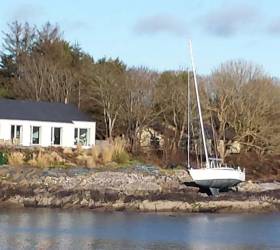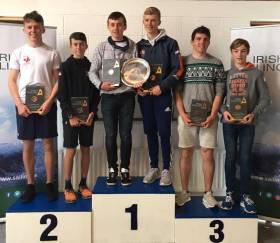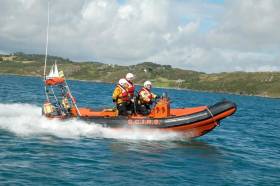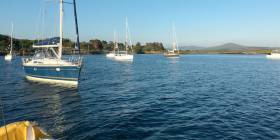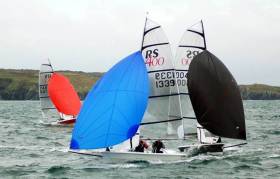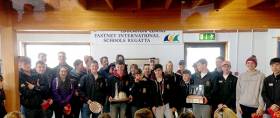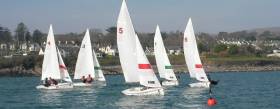Displaying items by tag: Schull
Attempt to Refloat West Cork Yacht This Morning
Attempts to recover a 32–foot that went aground in Schul, West Cork during Storm Ophelia get underway this morning.
A recovery team is expected to slide the yacht down the rocks and back into the water using inflated rubber bags.
Kinsale Yacht Club Crew are Junior All Ireland Sailing Champions
Kinsale Yacht Club youth sailors Michael O'Suilleabhain and Michael Carroll were the winners of this afternoon's All Ireland Junior Sailing Championships sailed at the Fastnet Outdoor Marine Education Centre in TR 3.6 double handed dinghies.
Saturday's light and shifty conditions gave way to soid breeze for today's single medal race final.
 Tight competition in the junior all Ireland sailing finals in Schull. Scroll down for video below. Photo: Robin Bateman
Tight competition in the junior all Ireland sailing finals in Schull. Scroll down for video below. Photo: Robin Bateman
The West Cork pairing beat two National Yacht Club crews from Dun Laoghaire who were challenging for the overall title. Rian Geraghty-McDonnell and Harry Durcan and Loghlen Rickard and Nathan Van Steenberge finished second and third respectively.
Overall results:
| Michael O'Suilleabhain | Michael Carroll | Kinsale YC | (13) | 1 | 1 | 1 | 5 | 9 | 6 | 36 | 23 | ||||
| Rian Geraghty-McDonnell | Harry Durcan | National YC | (6) | 2 | 5 | 5 | 3 | 3 | 10 | 24 | 28 | ||||
| Loghlen Rickard | Nathan Van Steenberge | National YC | 2 | 6 | (9) | 3 | 6 | 2 | 14 | 42 | 33 | ||||
| Ronan Walsh | Tom Higgins | Royal CorkYC | 4 | 5 | 2 | 4 | 2 | (6) | 16 | 39 | 33 | ||||
| Johnny Durcan | Emily Cullen | Royal Cork YC | 1 | 3 | 3 | 2 | (7) | 5 | 20 | 41 | 34 | ||||
| Chris Bateman | Daniel Hegarty | Royal Cork YC | (7) (+5 SP) | 4 | 4 | 7 | 10 | 8 | 2 | 47 | 35 | ||||
| Jack Fahy | Noah McCarthy-Fisher | Lough Derg YC Royal Cork YC / Royal StGeorge YC | (19) (+5 SP) | 13 | 8 | 9 | 9 | 1 | 4 | 68 | 44 | ||||
| Luke McGrath | Kate Darcy | Royal Cork YC | (16) | 10 | 7 | 6 | 12 | 4 | 8 | 63 | 47 | ||||
| Caolan Croasdell | Alexander Farrell | Lough Ree YC | 10 | 9 | 6 | 11 | 4 | (15) | 12 | 67 | 52 | ||||
| Joseph Karauzum | TC Mulvenna | Ballyholme YC / County Antrim YC | 11 | 7 | 11 | 12 | 1 | (13) | 18 | 73 | 60 |
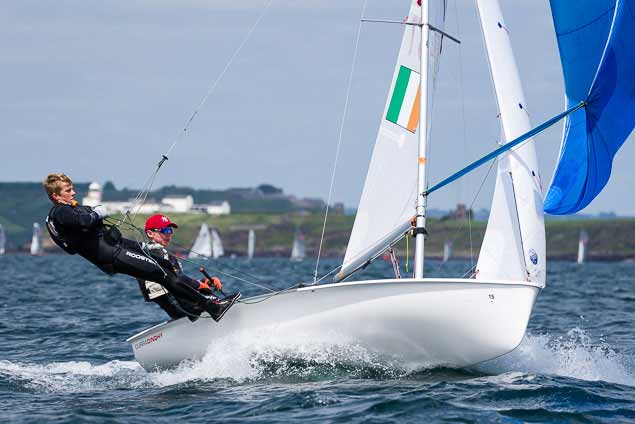 Winning duo – The Kinsale Yacht Club youth sailors Michael O'Suilleabhain and Michael Carroll are a 420 dinghy partnership seen here at Dinghy Fest 2017 at Royal Cork Yacht Club. Photo: Bob Bateman
Winning duo – The Kinsale Yacht Club youth sailors Michael O'Suilleabhain and Michael Carroll are a 420 dinghy partnership seen here at Dinghy Fest 2017 at Royal Cork Yacht Club. Photo: Bob Bateman
Schull’s Community Lifeboat To Join Irish Coast Guard
#Rescue - Schull’s independent community lifeboat will soon join the Irish Coast Guard, as the Southern Star reports.
Established in 2005, the Schull Community Inshore Rescue Service will be officially renamed as Schull Coast Guard later this month after two years of talks on assimilating the West Cork volunteer rescue service with the national SAR agency.
A reception is planned to mark the change, details of which will be announced on the SCIRS Facebook page.
The Southern Star has more on the story HERE.
Schull Marina Project Closer To Fruition As Funding Sources Targeted
#IrishMarinas - A long-awaited marina development in Schull Harbour may finally get under way if funding from three possible sources can be secured, according to the Southern Star.
Fáilte Ireland, the Coastal Infrastructure Capital Programme and EU funds have been identified as target sources to make up the majority of the €6 million budget for the project, which includes a new slipway and public promenade, that was first greenlit by planners a decade ago.
Cork County Council also told councillors at a recent meeting that €375,000 will be allocated to match €1.125m in public funding for necessary pier works.
Planning permission for the 200-plus-berth marina was due to run out this year, as previously reported on Afloat.ie, but it has now been extended till 2022 — though a foreshore lease must come before any work can begin.
The Southern Star has more on the story HERE.
Show of Youth Sailing Strength for Royal St. George As Big Breeze Forecast for Junior All–Irelands
Tomorrow's All Ireland Junior sailing championships looks like it will get off to a wet and windy start for the 16–nominated junior sailing stars drawn from seven yacht clubs from around the country.
The Under–18 championships is scheduled to race over two days in West Cork's own TR3.6 two handed dinghies but the weather forecast for the Schull venue shows winds topping 40–knots for Saturday and the same again on Sunday.
 XC weather forecaster shows big winds in Schull, West Cork tomorrow
XC weather forecaster shows big winds in Schull, West Cork tomorrow
In a show of strength for Dublin's Royal St. George Yacht Club more than a third of the participants are drawn from the Dun Laoghaire club. RStGYC juniors are representing the RS200 (Toby Hudson Fowler), the RS Feva (Henry Start), Laser 4.7 (Peter Fagan), Optimist (Tom Higgins), Topper (Jack Fahy) and Kate Lyttle from the 420 class.
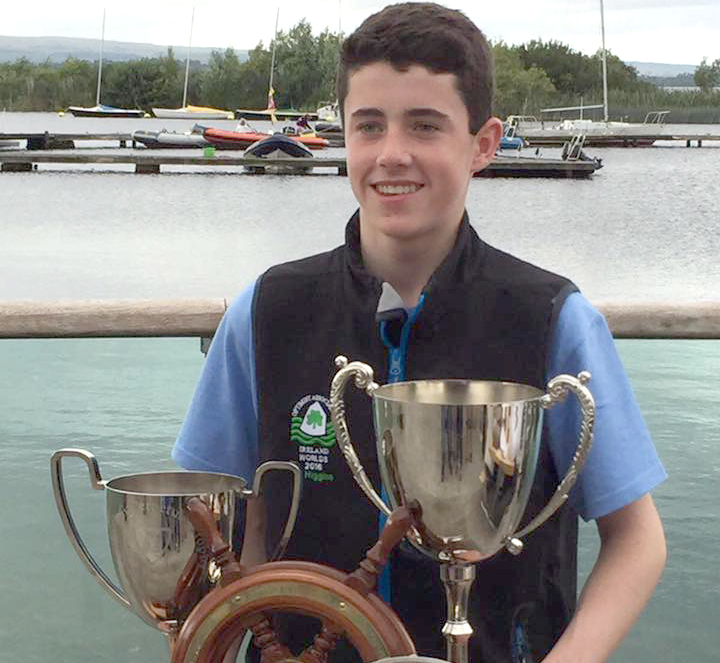 Multi–champion in the Optimist class, Tom Higgins from the Royal St. George, is nominated for this weekend's All Ireland Juniors in Schull
Multi–champion in the Optimist class, Tom Higgins from the Royal St. George, is nominated for this weekend's All Ireland Juniors in Schull
Royal Cork Yacht Club is the next biggest club on the water in Schull with four sailors involved. 29er skipper Harry Durcan and twin Johnny representing 29er and Laser Radials respectively. Harry Twomey represents the Optimist class and Sophie Crosby sails for the Toppers.
The National Yacht Club's Clare Gorman represents the Laser 4.7 and will defend the girls title and the NYC's Leah Rickard sails for the Optimists.
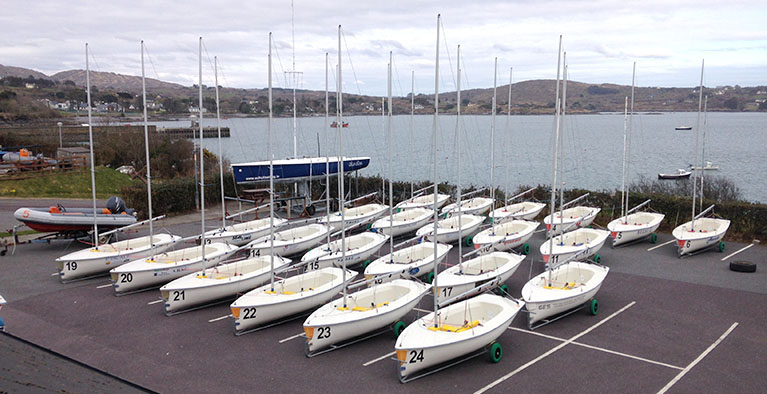 Schull's own TR3.6 dinghies ready for the junior all Ireland sailors. Photo: Fastnet Marine
Schull's own TR3.6 dinghies ready for the junior all Ireland sailors. Photo: Fastnet Marine
The West coast is represented by three clubs.Topaz sailors Adam Byrne and Dylan Reidy representing Dingle SC and Foynes YC respectively and Sligo Yacht Club sends Mirror ace Sarah White.
The 420 class is represented by Geoff Power of Waterford Harbour Sailing Club.
Full nominee list below
| Class | Name | Surname | Club |
|---|---|---|---|
| RS200 Junior | Toby | Hudson Fowler | Royal StGeorge YC |
| RS Feva | Henry | Start | Royal St George YC |
| Mirror | Sarah | White | Sligo YC |
| Laser 4.7 | Clare | Gorman | NYC |
| Laser 4.7 | Peter | Fagan | Royal St George YC |
| Laser Radial | Johnny | Durcan | RCYC/NYC |
| Topaz | Adam | Byrne | Dingle SC |
| Topaz | Dylan | Reidy | Foynes YC |
| Topper | Jack | Fahy | RSTGYC |
| Topper | Sophie | Crosby | RCYC |
| 420 | Geoff | Power | WHSC |
| 420 | Kate | Lyttle | RStGYC |
| OPTIMIST | Tom | Higgins | RSGYC |
| OPTIMIST | Harry | Twomey | RCYC&CHSC |
| OPTIMIST | Leah | Rickard | NYC |
| 29er | Harry | Durcan | RCYC |
RS400 & RS200 Fleets Put on A Show At Fastnet Marine Centre, Schull
33 RS’s travelled to Schull last weekend to battle for the National title. The event, kindly sponsored by Centra, saw 10 races completed for each class across two race courses with sailors experiencing the perfect mix of conditions. IRO Alan Crosbie & team took charge of the RS400 fleet South of Long Island and NRO David Harte & team took charge of the RS200 fleet outside Schull Harbour near Castle Island.
Friday- Glorious sunshine and light steady breezes ranging from 5 – 8 knots made for challenging but fair racing. The RS400’s completed all four races, two of which were sailed outside Long Island in dying breeze and two of which brought sailors back inside the sound where the breeze was just about holding up. In the RS400’s, reigning national champions Alex Barry & Richard Leonard appeared to have had a good day with a 1,1,3,4 only to have been OCS in race 1 which meant Bob Espey and Tiffany Brien took the overnight lead with a 5,3,1,3. The weekend was to continue to be a battle between the two teams with it going right to the wire on Sunday. There were four different race winners on the day with class stalwarts Emmet & James Ryan taking race one and laser supremo Chris Penney and Simon Martin taking race four. Katie Tingle and Fionn Lyden deserve a mention for leading to the first windward mark in race four in what was their first outing ever in an RS400 and likewise, a strong performance on the day for Laser Radial sailor Johnny Durcan and crew Grattan Roberts who sat in 5th overnight.
The RS200’s managed three races on Friday, Neil Spain and crew Shane Hughes had no intentions of being bridesmaids again and lead the unstoppable Marty O’Leary and Rachel Williamson by one point overnight. It seemed this was a sign of the weekend to come with the two boats continuing to blaze a trail on the rest of the fleet for the weekend. Jocelyn Hill and Katie Kane from Antirm had a great day and lay in 3rd place overnight.
Super Saturday: An earlier start of 11am on Saturday allowed for four races to be completed by both fleets. Winds had increased considerably from Friday and sailors enjoyed the perfect RS conditions with a South Easterly wind blowing 15 – 20 knots all day. The new breeze meant for a change in faces at the top of the RS400 fleet. Class President Dave Cheyne and Stevie Kane having sat 13th overnight came out blazing with a 1,2 in the first two races and scored an impressive 15 points on the day having scored 50 the previous day. Likewise David Rose and Ian Hef had a very strong day with a 3,7,2,2 to score 14 points having scored 49 the previous day. At the top of the fleet things weren’t looking good for the leaders with Bob & Tiff scoring a DNF in race one having to return to shore with slot gasket issues and Alex & Richie broke a rudder before the race but just made the start having secured a replacement. Bob & Tiff were back out of the blocks and recovered to score a 1,4,4 with Alex & Richie under pressure after a 4,5 managing to close the day with a 1,1. This left Alex & Richie in the lead by a mere 2 points going into the last day. The day took its toll with sailors bruised and battered but still smiling and three boats on their side over night as their owners prayed that the replacement slot gaskets would dry overnight.
In the RS200’s Neil and Shane took the spoils scoring an impressive four 1st places and showing they meant business. Marty & Rachel had a DNF in the first race but came back out to take three 2nd places. Past President Frank O’Rourke with local sailors Noah McCarthy were back on form with four 3rd places on the day but consistency on day one was rewarding Royal St. George pair Toby Fowler and Greg Arrowsmith who sat in 3rd place overnight. Special mention must go to the three boats from Cullaun Sailing Club who persevered on the day and particularly Aoife Cleary Ward and Niamh Edwards who were still smiling coming up the slip.
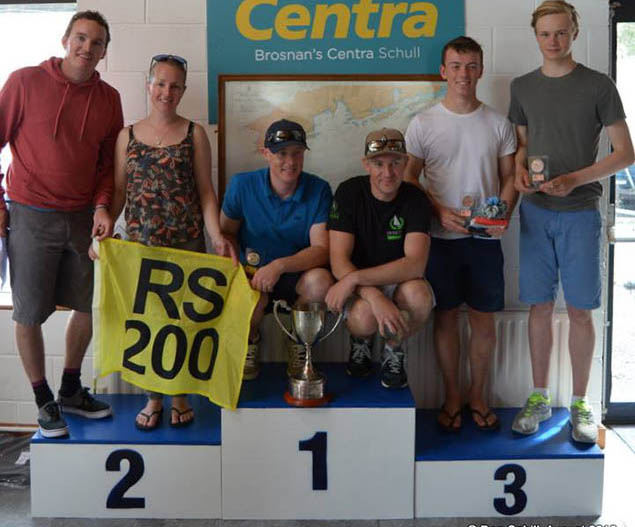 The RS200 Prizegiving
The RS200 Prizegiving
Sunday: The RS400’s had two final races on Sunday with all three medal positions up for grabs. Sailors were greeted outside by a giant Atlantic swell and very light and shifty conditions as the sea-breeze fought the thermal North Westerly. With Alex and Richie scoring a 2nd over Bob and Tiff’s 3rd in race one Paddy Power had the odds in the Cork boys favour. All they needed was for Bob and Tiff not to win the race or for them to score a fourth but having hunted each other down in two general recalled starts, the Northern team slipped away on the first beat and found the best breeze to lead by ‘miles’ at the top mark, a lead they carried safely all the way to the finish. Alex & Richie were left at the back of the fleet having fallen foul to the conditions and could only watch on as Bob Espey and Tiffany Brien crossed the line to secure the 2016 National Championships by one point, this being Bob’s second time securing the trophy and first time winning the event outright. Alex and Richie did enough for second place and Emmet and James Ryan did enough to fight off the pressure from young guns Johnn Durcan and Grattan Roberts to take third place and the bronze ISA medal.
The RS200’s needed three races to complete the card and with it all but sewn up, Neil and Shane had a scare in race 1 scoring a 3rd while Marty & Rach took the bullet. This wasn’t enough to phase the experienced pair who went on the win race two giving them the 2016 National Title and the freedom to head home early and miss the last race. A convincing win for the boys left them with 9 points and Marty & Rachel went on to win the final race giving them the silver medal on 13 points. Toby Folwer and Greg’s consistency continued as they scored a 2,5,2 on the day securing them the Bronze medal.
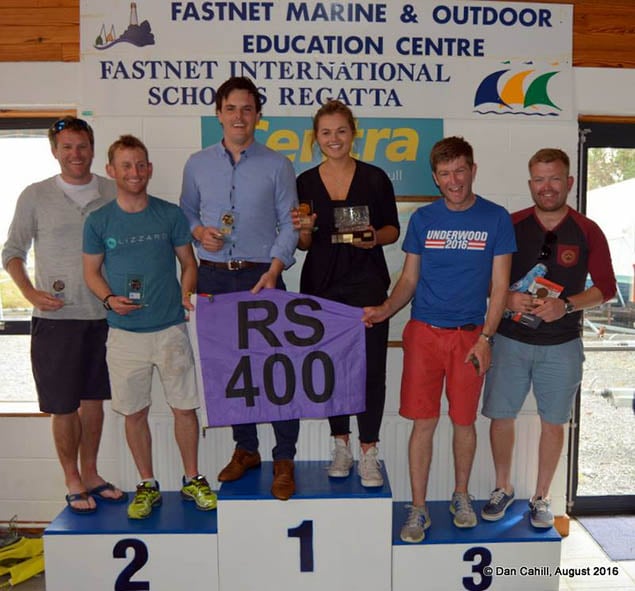 The RS400 Prize Giving
The RS400 Prize Giving
Social: Brosnan’s Centra in Schull kindly layed on a BBQ immediately after sailing each day which was very well received by sailors. Despite the tiring conditions of Super Saturday and impromptu party kicked off in the upstairs of Newman’s bar with massive craic had, a South v North sign off, apt for the year that’s in it, adding to the banter. Special mention for John Downey and Stevie Kane who’s countries can be very proud of their performances on the night.
All in all an excellent weekend was had by all, only made possible by David Harte and his massive team in the Fastnet Marine Outdoor Education Centre in Schull including RS400 OOD Alan Crosbie, the generous support from Centra, the people of Schull for providing camping facilities, good food and tasty pints.
Full results here
The next event for the classes is the end of seasons in Blessington SC on the 24th & 25th September.
The International Schools Team Racing Championships sailed in Schull, West Cork at the weekend was a huge success, with the event being the first time this number of schools from the United States, England and Ireland had competed together in Team Racing.
15 teams sailed in ideal conditions; winter switched off and summer switched on.
The event was tightly fought for between Schull Sharks and Presentation Brothers Cork from Munster and Tabor Academy and Cape Cod Academy from the United States, all taking races from each other.
The final outcome was not known until the second last race, when Cape Cod Academy lost to Tonbridge college from the UK allowing PBC through as the overall winners.
1st PBC (Ireland)
2nd Cape Cod (USA)
3rd Tabor Academy (USA)
4th Schull Sharks (Ireland)
5th International (Ireland & USA)
6th Tonbridge college (England)
USA Crews Line Up for Inaugural International Schools Team Racing Championships in Schull
The inaugural International Schools Team Racing Championships will take place in Schull, West Cork from the 18th –20th March.
16 teams are entered, with Tabor Academy and Cape Cod Academy sending four teams from the USA arriving on the 16th, in time to take part in the Schull St Patricks Day parade with the Schull teams.
The international event has developed from Schull Sailing Teams traveling every two years since 2007 to visit US schools in the New England area, hopefully this will be a biennial event.
Four teams are coming from the UK, including Sevenoaks, Tonbridge, James Alexander Gordon and Burford schools.
The American schools are doing home stay with the Schull sailors.
Eight teams are entered from Ireland, mainly from Munster with one team from the RstGYC.
Schull Marina Project Needs Funding – Former Cork Mayor
Planning permission for a 235–berth marina is due to run out in 2017. General Election Candidate and former Mayor of Cork Cllr Alan Coleman has claimed that funding to get the marina and pier extension project in Schull up and running must be a priority for the next government in a report in the West Cork Times.
The €6million project requires €2.5 million Government funding, Coleman says.
Schull Harbour Sailing Club based in the picturesque harbour that is part of the Wild Atlantic Way says 'If the funding can beorganised this could be a major advance for marine activity around Schull and West Cork'.
Coleman claims the West Cork town 'has been let down by the present government despite three government TDs in West Cork'.
“This marina can be a huge attraction to the area to broaden tourist season and make Schull and the Mizen a destination of choice, says Coleman.
“I have seen the huge economic benefit of investing in three marinas in Kinsale and it has sustained a longer season and made the area more attractive for visitors. A more vibrant tourist season will make the rural economy more sustainable' he said.
More on this story from West Cork Times here.
420s Announce Munster Champs & Coaching at Schull This February
The Irish 420 class will stage its 2016 Munster Championships and open coaching session at Schull Sailing Centre during the February Mid-Term break.
Coaching will take place from Saturday 13th (registration only) to Tuesday16th February with Ross Killian - ISA National Coach - leading the coaching team. The Munster Championships will take place on Thursday 18th and Friday 19th.
The Committee are currently looking at accommodation options and will announce full details of both events in the coming days.





























